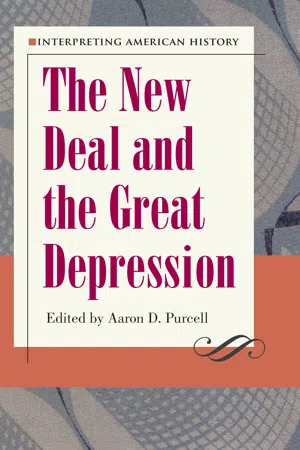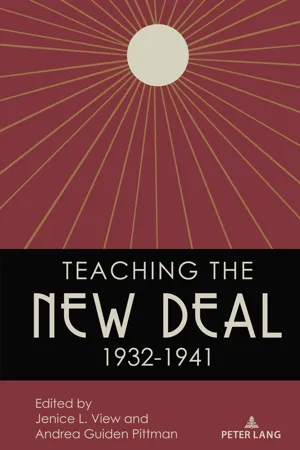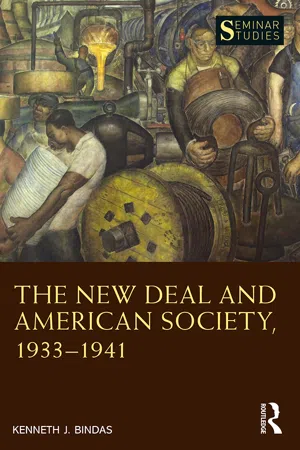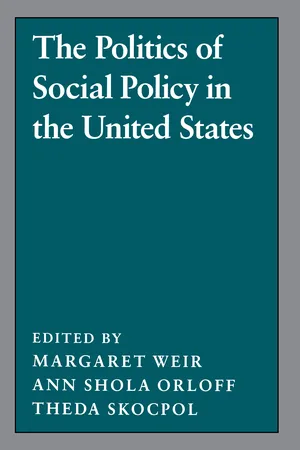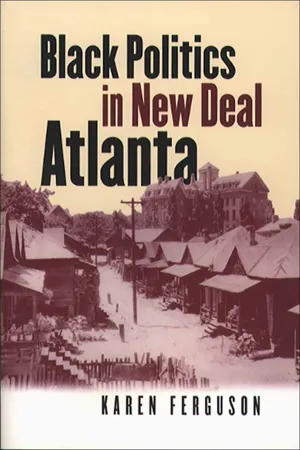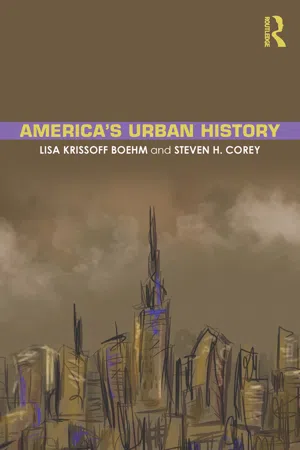History
African Americans and the New Deal
African Americans and the New Deal refers to the impact of President Franklin D. Roosevelt's New Deal policies on the African American community during the 1930s. While the New Deal aimed to provide economic relief, African Americans faced discrimination and unequal access to New Deal programs. Despite these challenges, the New Deal era saw some improvements in employment opportunities and the establishment of organizations advocating for civil rights.
Written by Perlego with AI-assistance
Related key terms
1 of 5
6 Key excerpts on "African Americans and the New Deal"
- Aaron D. Purcell(Author)
- 2014(Publication Date)
- The Kent State University Press(Publisher)
PART IIThe Fringes of the New Deal
Passage contains an image
CHAPTER EIGHT
African Americans and the Politics of Race during the New Deal
GLORIA-YVONNE WILLIAMS
The New Deal marked a pivotal moment in the African American struggle for equality and justice. Franklin D. Roosevelt’s New Deal introduced an expanded notion of democracy that transformed American social policy and provided a medium for African Americans to challenge existing racial boundaries. As a progressive Democrat, Roosevelt presented the New Deal as a way to serve the American people regardless of race, creed, or cultural background. In 1933, Roosevelt described his “new national administration” as one that would “restore the confidence” and “bring about governmental action to mesh more with the rights and the essential needs of the individual man and woman.”1 By the mid-1930s the New Deal created economic and political opportunities for African Americans through its policy of inclusion, which at that time was a fundamental step toward gaining recognition of their civil and political rights.African American leaders and activists embraced the New Deal’s reformist agenda as a vehicle to challenge racial inequities throughout government and society. In the 1940s, African American journalists Roi Ottley and Henry Moon viewed the political agency of African American leaders and activists as critical to the advancement and recognition of their full citizenship. Not since Reconstruction had African Americans been given the opportunity to participate in government reforms. Political scientists Minion K. C. Morrison and Richard Middleton IV acknowledged that “[t]he New Deal offered by Franklin Roosevelt is regarded as the first fundamental shift in African American representation.”2- eBook - PDF
- Jenice View, Andrea Guiden Pittman, James Mitchell, Charlotte L. Johnson, Erik Alexander, Caroline R. Pryor, Michael E. Karpyn, Jenice View(Authors)
- 2021(Publication Date)
At the same time, students will encounter the NAACP’s initiation of legal campaign against segregation, the role of Black women as fundrais- ers and community organizers when federal relief program failed Black communities, the impact of both the Scottsboro Trial and the Tuskegee Experiments, and the founding of the National Negro Congress. In other words, where many textbook chapters on the New Deal Era focus on the economic impact of the Great Depression, this explains how existing social and economic inequities worsened or, at the very least, became more com- plicated during the 1930s. In this, we would expect students to compare the narrative and supporting evidence of both this book and the locally adopted United States history textbook. As an instructional planning note when teaching Compelling Question 4 on the legacy of the New Deal era, it would be critical to circle students back to the textbook African-American History (Hine, Hine & Harrold, 2011), as the text 38 | COOK AND EARGLE notes that a lasting impact of the New Deal Era is the onset of political realign- ment that occurs as Black voters begin to support the Democratic Party. Source 2: Robert C. Weaver, “The New Deal and the Negro: A Look at the Facts,” July 1935. Robert C. Weaver served in Franklin D. Roosevelt’s “Black Cabinet” and would go on to serve in the John F. Kennedy and Lyndon B. Johnson administrations. In this article, published in the aca- demic journal Opportunity, Journal of Negro Life, Weaver makes a case that the New Deal programs are positively impacting Black people in both urban and rural areas of the United States. When used with the textbook options, students should consider the authorship (a Black male working within the Roosevelt administration) in comparison to the text- books (offering often conflicting evidence on the promises and achieve- ments of the New Deal programs). - eBook - ePub
- Kenneth J. Bindas(Author)
- 2021(Publication Date)
- Routledge(Publisher)
The combined activity of the 100 Days legislation highlights the many compromises FDR needed to make to satisfy the multi-dimensional aspect of not only the Democratic party but the country as a whole. The party included white southerners who did not want any challenge to Jim Crow segregation, northeast banking and business people fearful of federal takeover and control, midwestern farmers concerned about the demise of their way of life, Great Lakes industrialists concerned about labor unrest, westerners worried about being left behind and ignored by an eastern establishment, as well as a myriad of other groups and areas worried that the crisis of the day was simply too much for the country to recover from. This first New Deal seemed to have something for everyone.Almost everyone. The New Deal and FDR’s activity regarding African Americans during this early phase was poor at best, given that in industrial areas like Detroit, Chicago, and Philadelphia the unemployment rate ran as high as sixty percent. FDR was unwilling to come out in favor of advancing Civil Rights and equality and often substituted his wife Eleanor or other key advisors to stand in for him at events or for comments. FDR felt he had to walk a tightrope regarding the New Deal and its push for racial equality. The Democratic party was a monolithic block throughout the white South and its leaders were ardent segregationists and the idea of using federal power to challenge their racist system would have weakened FDR’s position and ability to get legislation through the Senate. Also, African American voters, until the election of 1932, had been historically Republican. This election was the first time Black voters switched from the party of Lincoln to FDR and so they lacked a clear and focused voice within the party. Perhaps another explanation for the lack of concern for this group of Americans stems from the fact that the New Deal, in large measure, with its advocacy on consumption and the marketplace, was designed to enhance or build up the middle class, not to reform the economic inequality evident in the urban or rural poor, or even to rescue those marginalized by the ravages of capital. FDR did recognize the increasing power of African Americans within the party and formed what was called the Black Brains Trust in 1933 through the Federal Council of Negro Affairs and with the influence of NAACP chair Joel Spingarn and the interest of the Julius Rosenwald Fund. Serving as informal advisors, and with the support of the First Lady, Hopkins, and former Chicago NAACP president Ickes, the group encouraged the president to recognize the unique issues facing the nation’s African American population which would lead, in the second incarnation of the New Deal in 1935, numerous key appointments including Lawrence Oxley, Mary McLeod Bethune - Margaret Weir, Ann Shola Orloff, Theda Skocpol, Margaret Weir, Ann Shola Orloff, Theda Skocpol(Authors)
- 2020(Publication Date)
- Princeton University Press(Publisher)
Witte, The Development of the Social Security Act (Madison- University of Wisconsin Press, 1963), along with Jill Quadagno's essay in this volume (Chapter 6). 26 Kristi Andersen, The Creation of a Democratic Majority, 1928—1936 (Chicago, 111.: University of Chicago Press, 1979), chap. 6; Harvard Sitkoff, A New Deal for Blacks (New York: Oxford University Press, 1978), esp. chap. 4. 304 Skocpol the national Democratic party for civil rights and economic assistance. Among New Deal liberals were radical reformers who wanted to aid ten-ant farmers and agricultural laborers, including southern blacks; but these reformers were defeated by the American Farm Bureau Federation and by allied officials in Congress and the Agriculture Department. 27 From the mid-1930s onward, federal farm subsidies and other interven-tions in the agricultural sector aided richer commercial farmers and spurred the mechanization of southern farming. During World War II, moreover, military spending promoted urbanization and industrialization in the South. From the 1940s through the 1960s, blacks migrated in huge waves into southern and northern cities. 28 The shift of blacks from a predominately rural South to heavily populated urban areas located in the South and the North created the preconditions for the civil rights struggles of the 1950s and 1960s. 29 At last, American blacks had won the right to vote in all areas of the nation, and from the 1960s to the Jesse Jackson movement of the current period they have been mobilizing for fuller participation in local and national politics. Yet the migration of blacks from the rural South transformed their elec-toral status more thoroughly and quickly than it changed their economic status. For blacks arrived in America's central cities and heavy industries at a point when opportunities for upward mobility after starting in un-skilled industrial jobs were much less available than they were for earlier ethnic immigrants into American cities.- eBook - ePub
- Karen Ferguson(Author)
- 2003(Publication Date)
- The University of North Carolina Press(Publisher)
The New Deal's potential fueled the dreams of many members of Atlanta's black reform elite. Most basic, Georgia's New Deal administrators included African Americans at the center of their public welfare program, something that state and local Officials had steadfastly refused to do. Such recognition freed private black agencies from the burden of providing emergency relief, sponsored long-term black welfare goals such as the creation of public nursery schools, and, as we shall see in future chapters, even provided funds and lent federal prestige to projects sponsored by the black community. For most in Atlanta's black reform community, such acknowledgment of the black community's needs, let alone its existence, was a long overdue step in the road to full citizenship. Adequate income, housing, food, health care, and recreation were African Americans’ due, and the New Deal's implicit recognition of these rights provided an extraordinary boost to the long struggle for black civil rights. Organizations and reformers had long struggled privately for such basic recognition for black neighborhoods and citizens, but the New Deal brought these services to African Americans at a level only before dreamed of by black leaders.From the beginning, black reformers supported the New Deal enthusiastically, even though it threatened the autonomy and influence of Atlanta's voluntary black social-work community. The Neighborhood Union had already experienced in its unhappy dealings with the Community Chest the dangers of ceding control to white agencies in an effort to integrate into the larger reform community in the city. This threat certainly existed with federal intervention in Georgia and the different foci and emphases of the white social workers heading the federal machinery. Yet black reformers did not complain or voice concerns over these developments. For them, the potential threat posed by the New Deal was more than counterbalanced by the fact that federal relief agencies in Georgia hired black experts and included them in the administration of federal programs, within a social-work framework that matched their own ideology and program. These pioneer black bureaucrats, social workers, public-health nurses, adult education teachers, and black advisers became an integral part of the New Deal relief program in Georgia and brought the black reform elite in from the cold, thus fulfilling their decades-long dreams of incorporation. - eBook - ePub
- Lisa Krissoff Boehm, Steven Hunt Corey(Authors)
- 2014(Publication Date)
- Routledge(Publisher)
Whether or not Franklin Delano Roosevelt’s New Deal constituted a continuation of a natural cycle between conservative and progressive/ liberal eras, or a marked departure from the previous trajectory of American politics has been the subject of intense debate by political scholars since the 1930s. It is possible to consider the New Deal an extension of the populist and progressive trends of the late nineteenth and early twentieth centuries. Of course the progressive ideals had lain dormant or at least had retreated from the corridors of Washington, D.C. during the highly conservative era which preceded the stock market crash. Following World War I, known at the time as “The Great War,” the United States had undergone an inward-turning, conservative period. Xenophobic attitudes heightened during the 1920s, as we saw in the preceding chapter, leading to a growth in membership in the Ku Klux Klan and the enactment of anti-immigration legislation.Facing economic and social upheaval, American politicians turned once again to more liberal ideas. Some scholars and cultural critics read the New Deal as a vast departure from American political traditions. A subset of these academicians see the New Deal as radical in its approach, akin to the socialist trends sweeping Europe at the time and, for the more conservative-minded, far too close to the theoretical underpinnings of communism. Others, including the influential historian Richard Hofstadter, disagree. Hofstadter, who writes from the liberal tradition while still maintaining that the New Deal constituted a marked deviation from past policy, contends that the New Dealers considered their nation fundamentally broken in the 1930s, and that only sweeping actions by the federal government could remedy the nation’s weighty problems. Hofstadter, in his important work, The Age of Reform (1955), states that “The New Deal was different from anything that had yet happened in the United States: different because its central problem was unlike the problems of Progressivism; different in its ideas and its spirit and its techniques.”9 The scholarly disputes over understanding the period lay, as in most historical debates, not in what occurred during the period, but in how to trace the events back to the reasons for their occurrence, and to understand what they mean for those living in modern times. As historians Gerald N. Grob and George Athan Billias argue:When describing the operation of specific New Deal programs... the differences of opinion between historians tend to narrow sharply. Thus what the WPA [Works and Progress Administration], NRA [National Recovery Administration], and other federal agencies did is often not a subject of dispute. The issue that invariably leads to conflict is the intent of the participants. The controversy involves not the relief activities of the 1930s, to cite one instance, but whether or not the concept of federal relief undermined the cherished American ideas of individualism and liberty.10
Index pages curate the most relevant extracts from our library of academic textbooks. They’ve been created using an in-house natural language model (NLM), each adding context and meaning to key research topics.
